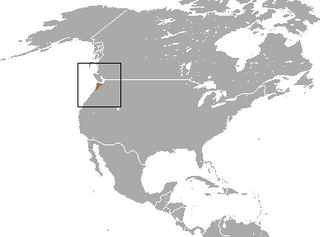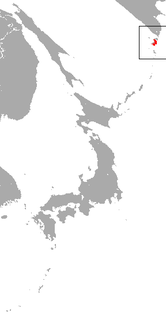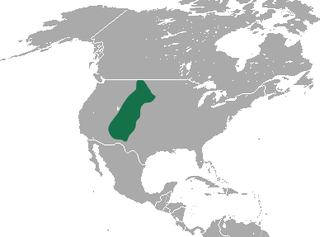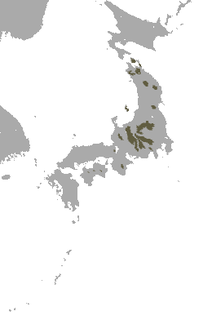
Emoia is a genus of skinks, lizards in the subfamily Eugongylinae. The genus Emoia belongs to a group of genera mainly from the southwestern Pacific-Australian region.

The red-toothed shrews of the subfamily Soricinae are one of three living subfamilies of shrews, along with Crocidurinae and Myosoricinae. In addition, the family contains the extinct subfamilies Limnoecinae, Crocidosoricinae, Allosoricinae and Heterosoricinae. These species are typically found in North America, northern South America, Europe and northern Asia. The enamel of the tips of their teeth is reddish due to iron pigment. The iron deposits serve to harden the enamel and are concentrated in those parts of the teeth most subject to wear.

The smoky shrew is a medium-sized North American shrew found in eastern Canada and the northeastern United States and extends further south along the Appalachian Mountains.

The genus Sorex includes many of the common shrews of Eurasia and North America, and contains at least 142 known species and subspecies. Members of this genus, known as long-tailed shrews, are the only members of the tribe Soricini of the subfamily Soricinae. They have 32 teeth.

The Olympic shrew is a rare species of shrew that lives in only 13 spots in northwest Washington State and, a recent discovery, in Burns Bog, located in Delta, BC.

The Arizona shrew is a species of shrew native to North America.

Baird's shrew is a species of mammal in the family Soricidae. It is endemic to northwest Oregon. Baird's shrew inhabits moist conifer forests. Its fur is darker brown in winter than in summer, when it is brownish-chestnut or olive brown, with paler sides and belly. Males and females are about the same size, which is common among shrews in general. Also like other shrew species, Baird's shrew feeds on insects, worms, snails, and spiders. It shares the forests of its range with six other species of shrew, such as the Pacific shrew. Body length ranges from 100 to 143 mm, with an average weight of 7.6 g, but ranging anywhere from 5.5 to 11.2 g.

The Iberian shrew or Lagranja shrew is a species of mammal in the family Soricidae. It is found in Portugal and Spain.

The Azumi shrew is a species of mammal in the family Soricidae. It is endemic to Japan, where it is found in the mountainous regions of central Honshu Island. It is a close relative of the Eurasian least shrew. It is threatened by habitat loss.

The Paramushir shrew is a species of mammal in the family Soricidae. It is endemic to Russia. Its natural habitat is temperate forests. It is threatened by habitat loss.

The dwarf shrew is a species of mammal in the family Soricidae endemic to Arizona, Colorado, Montana, Nebraska, New Mexico, South Dakota, Utah, and Wyoming in the United States. The type locality is Estes Park, Colorado, USA.

The ornate shrew, is a species of mammal in the family Soricidae (shrews). It is endemic to western North America, ranging from Northern California in the United States to Baja California in Mexico. Eight subspecies are known, including the extinct tule shrew, known only from four specimens collected in 1905, and the Suisun ornate shrew, a species of conservation concern in California. Through skull morphology research and genetic testing on Ornate shrew populations, it has been shown that there are three main genetic subdivisions: The Southern, Central and Northern. These three genetic subdivisions of Ornate shrew arose from populations of Ornate shrews getting geographically isolated from other populations.

Portenko's shrew is a species of mammal in the family Soricidae that is endemic to Russia.

Preble's shrew is a small shrew distributed across the Great Basin of the United States and southern British Columbia in Canada. It belongs to the order Eulipotyphla, family Soricidae and genus Sorex.

The Apennine shrew is a species of shrew in the family Soricidae. The mammal is endemic to Italy.

The Shinto shrew is a species of shrew of the genus Sorex that lives only on the islands of Japan. It is a mole-like mammal with a pointed snout, very small ears, and a relatively long tail. Like most shrews, it is tiny, has poor eyesight, and a very good sense of hearing and smell which it uses to locate its prey, mainly insects.

The Tibetan shrew is a species of mammal in the family Soricidae. It is found in western China.

The Verapaz shrew is a species of mammal in the family Soricidae. It is found in Guatemala and Mexico.

The New Mexico shrew is a species of mammal in the family Soricidae. It is found only in New Mexico in the Capitan, Manzano, and Sandia mountains. Its total length is 103 to 121 millimeters. Its tail length is 39 to 54 millimeters. It weighs 6 to 8 grams. It was included in Sorex monticolus until 1996. It is distinguished from Sorex monticolus by its teeth. The row of unicuspid teeth is longer in Sorex neomexicanus than in Sorex monticolus, and Sorex neomexicanus has a wider space between its first upper unicuspid and second upper unicuspid than Sorex monticolus does.

















